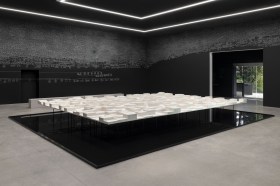Do you ever wonder if what you see by way of location in cinema is nothing more than propaganda? Director Alfred Hitchcock was severely criticized by Observer film critic Caroline Lejeune for making what she considered to be `travelogues` in sacrifice of any real political ethos. And whilst this `might` be true of his British output, it is undeniably true of the films which he made in America about Britain.
Think about it. Wouldn`t have that pivotal sequence in the director`s re-make of The Man Who Knew Too Much in 1956 have been that much better if when Doris Day visited Ambrose Chapel she had engaged with the working-class Anglo-Irish who lived in the neighbourhood and attended the parish church where she thought her son was being held captive?
But no. There wasn`t a soul on those dreary streets as Doris slummed it around Brixton – in garish Technicolour and wearing Haute Couture by Edith Head.
Just think of the difference it would have made to attitude and pov if the film had been shot in black and white? It would have truly been, as Hitchcock said of the re-make, a mature version of the 1934 original and a consequential development of Hitch`s Gaumount genius rather than an aberration of that genius.
The same thing could be said of Hitchcock`s Frenzy, a re-hash of the Jack the Ripper theme but with the director`s `wrong man` motif.
Covent Garden was a voyeur`s fantasy in Frenzy and although Hitch told his cinematographer Gil Taylor he didn`t want `another Technicolour bauble`, the storyboarding of locations subverted any possibility of the film having either the light wit or funky veracity of Charles Crichton or any of the great British directors of the golden era.
Of course by the time director Crichton (Hue and Cry etc) made A Fish Called Wanda in 1988 (his last film) he had become a purveyor of Hollywood London fantasy – not as bad but almost – as Richard Curtis.
The old British films – The Blue Lamp with its Marylebone locations, It Always Rains on Sunday (Arthur La Bern) about London`s Spitalfield and East End, Expresso Bongo (Wolf Mankiewicz) about the Soho area – had a bittersweet quality which at least tried to convey something naturalistic and efficacious about British life.
I know that author Arthur LaBern (Farewell Piccadilly, Good-bye Leicester Square) upon whose novel Hitchcock based Frenzy carped loudly and wrote a letter to the newspapers about Hitch`s distortion of the novel. LaBern fixated on the director`s parody of the police (because it was so obvious and OTT) but he could have picked on any aspect of the film.
LaBern was a fine locations novelist who managed to document the demise of some of London`s oldest precincts at a time when (as today) they were faced with regeneration and redevelopment. It Always Rains on Sunday , directed sympathetically by Robert Hamer, was a fine account of what was happening to the old Spitalfield area where currently the old Huguenot houses are selling for millions and millions of pounds.
A threnody for the demise of old Covent Garden, which soon would be shifted to Nine Elms and a wholly wholesale precinct, LaBern`s novel aggravated about the removal from traditional neighbourhoods of London`s street markets. His `take` on Covent Garden was bleak, bittersweet, nostalgic and self-conscious.
So what did Hitchcock do? Transposing LaBern`s threadbare Covent Garden locations at Endell street and Endell Alley into grand precincts of Covent Garden`s Inigo Jones piazza on Henrietta Street, Hitchcock shifted the focus and turned the film (according to director Mike Liegh and others) into a tawdry representation of anachronistic London.
If the tradition of British cinema continues at all, it continues in the films of Leigh, Stephen Frears and a couple of others well into their sixties who learned at the knee of the old British masters.
The new stuff of UK cinema – the Richard Curtis films – is a complete and utter distortion, and panders to the travelogue aspect of location filmmaking to excess.
An example of this is the current film, Miss Pettigrew Lives for a Day, which is (weirdly) about the way the UK (and American) upper classes lived it up (in London) prior to the start of World War II and the Holocaust. The script panders. The direction panders. But worst of all, the cinematography panders. The film should win an Oscar for its cinematography. The colour is vintage stuff.
But the fact is it tends to obscure the reality (if there is one) and rather than bittersweet the film is an all-out embrace of hedonism and sycophancy during the run-up to the Holocaust.
Do we know? Do we care?
Fact is we should!




